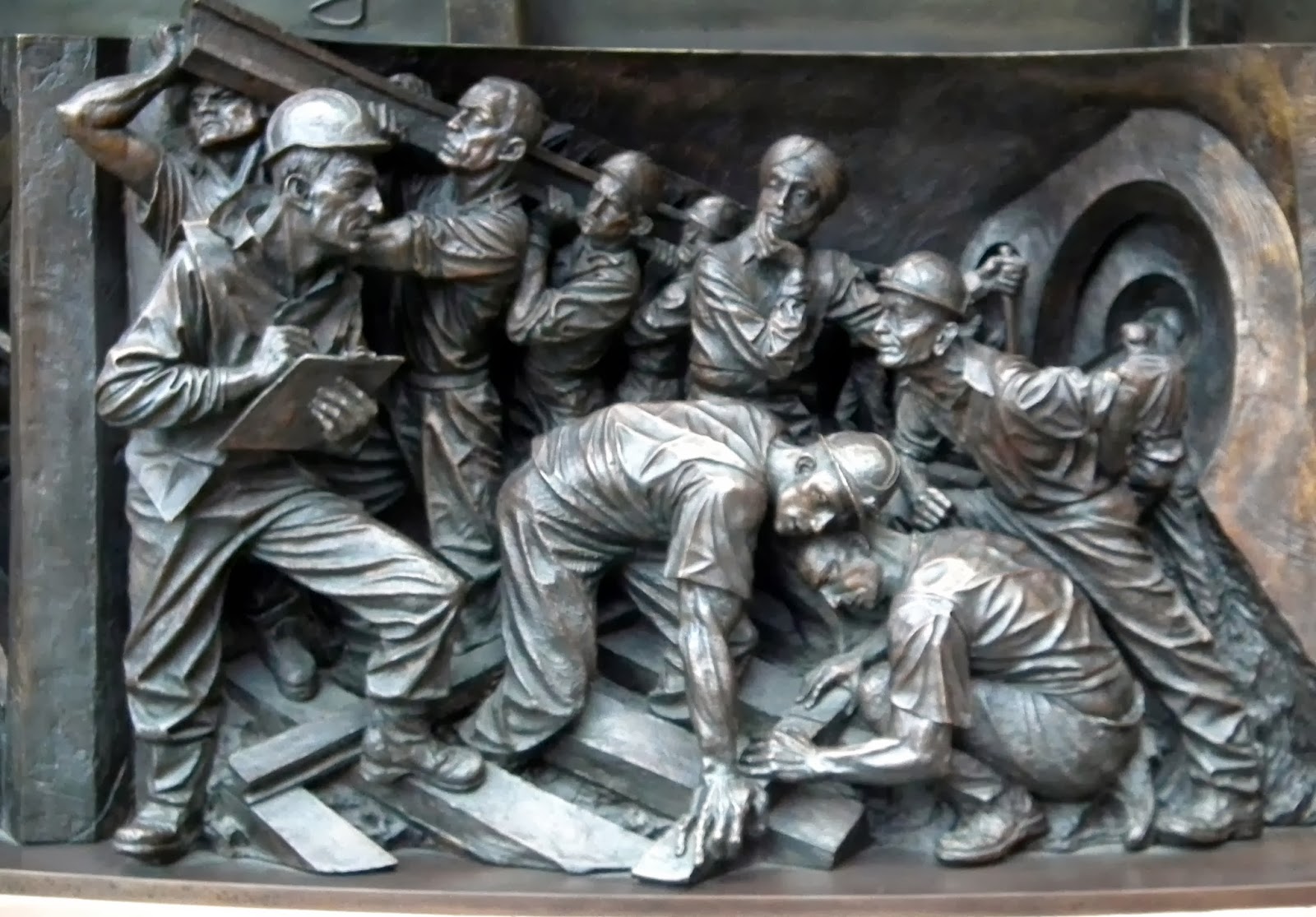The Daily Mail had a field day, as you can imagine, and the design was altered. It is now fairly innocuous.
Tuesday 28 January 2014
St Pancras Station, N1
Paul Day's colossal bronze of a pair of lovers embracing still divides opinion. For some it is a lovely, elegant, swirling image of joyful reunion. To others it is 30 feet confection of kitsch covered in golden syrup and with a cherry on top. Even Antony Gormley had a go.

 The Meeting Place has some style and poise, but who could possibly have imagined that any object could be too big even for the vasty cavern of St Pancras?
The Meeting Place has some style and poise, but who could possibly have imagined that any object could be too big even for the vasty cavern of St Pancras?

 In the event, it was the frieze below that created the biggest kerfuffle. It was added after the statue had been erected. The plaster maquettes were displayed before they were cast, and some of the subjects caused deep offense.
In the event, it was the frieze below that created the biggest kerfuffle. It was added after the statue had been erected. The plaster maquettes were displayed before they were cast, and some of the subjects caused deep offense.

 One was a train coming up behind a drunken tramp tottering down the platform. The driver was a skeleton, deemed inappropriate on a system that sees occasional deaths.
One was a train coming up behind a drunken tramp tottering down the platform. The driver was a skeleton, deemed inappropriate on a system that sees occasional deaths.
 The other detail was a couple shagging on a late night platform in full view of the other passengers.
The other detail was a couple shagging on a late night platform in full view of the other passengers.
The Daily Mail had a field day, as you can imagine, and the design was altered. It is now fairly innocuous.


 For my taste, it is a bit like railway modelling with a splash of surrealism, though I do like the couple embracing, the man unaware that the girl is texting behind his back.
For my taste, it is a bit like railway modelling with a splash of surrealism, though I do like the couple embracing, the man unaware that the girl is texting behind his back.
The Daily Mail had a field day, as you can imagine, and the design was altered. It is now fairly innocuous.
Wednesday 15 January 2014
St Pancras Station N1
British Rail, one of the most ruthless of the corporate vandals that destroyed so much great architecture in the latter half of the 20th century, tried to push through plans to demolish St Pancras station on the sly but an insider was so outraged he leaked the proposals to the poet and architectural critic John Betjeman. Betjeman had failed in his campaign to save the great arch at Euston station just up the road, but now public anger was stoked up and this time the forces of barbarism were thwarted. In 2007 a statue commemorating him was unveiled in the brilliantly restored station.
The figure, by Martin Jennings, looks upwards in wonder at the soaring arch, the widest in the world at the time. His coat swings behind as his gaze moves.
Portraying movement in a statue is a difficult trick to pull off, but Jennings has managed to capture a moment without making it look as if Betjeman was frozen in mid-air by the White Queen. And he has caught the Poet Lauriate's famous unconcern with matters sartorial brilliantly. Note that one of his shoes is tied with string.
Friday 3 January 2014
St Thomas' Hospital SE1
Revolving Torsion (1972-3) is a late work by the Russian sculptor Naum Gabo, who died in 1977.
Born Naum Pevsner in Russia, he changed his name when he took up sculpture to avoid confusion with his elder brother Antoine who was a painter. He was a truly international modernist, fluent in several languages, studying medicine, science and engineering in Munich before becoming a full-time artist and working in Paris, Copenhagen and Oslo. At the outbreak of the Russian Revolution he returned to Moscow where he pioneered the Constructivist movement, even coining the name.
Later he moved to Germany to teach at the Bauhaus, developing the theory of Kinetic Art that aims to exploit motion or the illusion of motion for its impact.
As a Jew, the rise of the Nazis forced him to move first to Paris and then to London. In 1946 he went to America.
Revolving Torsion certainly has a lot of movement in it, looking like a part of some turbine that interacts with the multiple jets of the fountain. Creating the sweeping stainless steel blades must have drawn considerably on the engineering skills he had picked up all those years before.
Unfortunately it is rather upstaged by the building behind.
Subscribe to:
Posts (Atom)